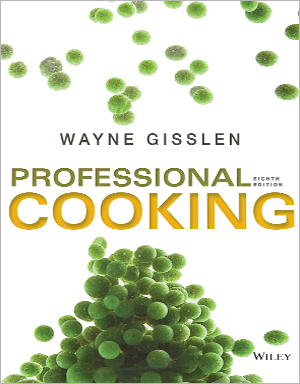
Professional Cooking, 8th Editionn
By Wayne Gisslen
This Eighth Edition of Professional Cooking reflects the changing nature of cooking and related fields such as food safety, nutrition, and dietary practices, as well as new thinking about how best to teach this material. This edition continues to support the core curriculum with a focus on the fundamentals, the comprehensive understanding of ingredients, and basic cooking techniques that are the building blocks of success in the kitchen.
Schedule a Demo Sign Up for a Test Drive Adopt WileyPLUSWant to learn more about WileyPLUS? Click Here
Recipes that Work
Through eight editions now, students and instructors have depended on thoroughly tested recipes for proven results, which means that students learn without frustration, and precious food resources and budgets are not wasted.
Realistic Procedures
Although supported by discussions of cooking theory, procedures are based on actual industry practices. Attention is given not just to quantity production but also to the special problems of cooking to order.
Recipe management system helps students apply concepts to everyday life.
The CulinarE-CompanionTM Recipe Management Software is a web-based database of recipes from the textbook, accessible from any device’s browser, whether a laptop, desktop, tablet, or mobile device. In addition to the recipes from the book and additional bonus recipes, the software includes a range of useful features. The registration code included with each copy of Professional Baking, 7thEdition allows access to this valuable asset at no additional cost—and accounts do not expire, so it can be used throughout one’s professional career.
- More than 125 new images detail cooking procedures and reflect modern plating styles.
- A new chapter (Chapter 14) outlines in detail the cooking methods for meats, poultry, and fish and now precedes the six chapters devoted to these products. This new chapter combines basic techniques and procedures common to these foods, and reinforces understanding with background information, guidelines, and standards of quality for finished dishes. Procedures are extensively illustrated with photos, and a core recipe that embodies the technique follows each procedure.
- Further reorganization of chapters and content provides a smoother, more logical flow for the introductory chapters and repositions the chapters on vegetable cooking ahead of meats and fish.
- Chapter 29 on food presentation and plating has been rewritten and newly illustrated to give the reader the tools to design modern platings appropriate for all types of food service operations.
- Reduced yields for large-quantity recipes, in response to instructors’ requests.
Features Include
WAYNE GISSLEN is the author of the best-selling series of culinary books that includes Professional Cooking, Advanced Professional Cooking, and Professional Baking—all published by Wiley.& A graduate of The Culinary Institute of America, he has written extensively in the field of culinary arts, with experience as a restaurant chef, test-kitchen supervisor, and food-and-beverage consultant.
Chapter 1: The Food-Service Industry
Chapter 2: Sanitation and Safety
Chapter 3: Tools and Equipment
Chapter 4: Menus, Recipes, and Cost Management
Chapter 5: Nutrition
Chapter 6: Basic Principles of Cooking and Food Science
Chapter 7: Mise en Place
Chapter 8: Stocks and Sauces
Chapter 9: Soups
Chapter 10: Understanding Vegetables
Chapter 11: Cooking Vegetables
Chapter 12: Potatoes
Chapter 13: Legumes, Grains, Pasta, and Other Starches
Chapter 14: Cooking Methods for Meat, Poultry, and Fish
Chapter 15: Understanding Meats and Game
Chapter 16: Cooking Meats and Game
Chapter 17: Understanding Poultry and Game Birds
Chapter 18: Cooking Poultry and Game Birds
Chapter 19: Understanding Fish and Shellfish
Chapter 20: Cooking Fish and Shellfish
Chapter 21: Salad Dressings and Salads
Chapter 22: Sandwiches
Chapter 23: Hors d’Oeuvres
Chapter 24: Breakfast Preparation
Chapter 25: Dairy and Beverages
Chapter 26: Cooking for Vegetarian Diets
Chapter 27: Sausages and Cured Foods
Chapter 28: Pâtés, Terrines, and Other Cold Foods
Chapter 29: Food Presentation
Chapter 30: Bakeshop Production: Basic Principles and Ingredients
Chapter 31: Yeast Products
Chapter 32: Quick Breads
Chapter 33: Cakes and Icings
Chapter 34: Cookies
Chapter 35: Pies and Pastries
Chapter 36: Creams, Custards, Puddings, Frozen Desserts, and Sauces
Appendix 1: Metric Conversion Factors
Appendix 2: Standard Can Sizes
Appendix 3: Approximate Weight-Volume Equivalents of Dry Foods
Appendix 4: Kitchen Math Exercises: Metric Versions
Appendix 5: Eggs and Safety
Bibliography
Glossary and Cooking Vocabulary

